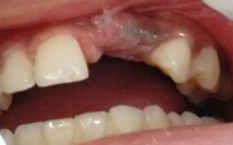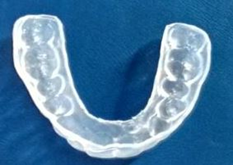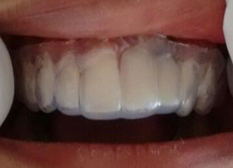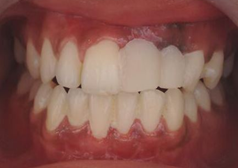Case Report
Volume 3 Issue 4 - 2018
Resin Bonded Direct-Indirect Temporization in Anterior Teeth-A Case Report
1Departmentof Prosthodontics and Crown & Bridge, Government Dental College and Hospital, Medical Campus, Medical Square, Nagpur, Maharashtra, India
2Departmentof Periodontics, Government Dental College and Hospital, Medical Campus, Medical Square, Nagpur, Maharashtra, India
3Department of Prosthodontics and Crown & Bridge, Government Dental College and Hospital, Medical Campus, Medical Square, Nagpur, Maharashtra, India
2Departmentof Periodontics, Government Dental College and Hospital, Medical Campus, Medical Square, Nagpur, Maharashtra, India
3Department of Prosthodontics and Crown & Bridge, Government Dental College and Hospital, Medical Campus, Medical Square, Nagpur, Maharashtra, India
*Corresponding Author: Suryakant C Deogade, Department of Prosthodontics and Crown & Bridge, Government Dental College and Hospital, Medical Campus, Medical Square, Nagpur, Maharashtra, India.
Received: June 05, 2018; Published: June 16, 2018
Abstract
Replacement of missing anteriors can be achieved by different options in fixed prosthodontics, including conventional Maryland bridges, implants, etc. Provisional crowns play an important role in protection and maintenance of abutment relations, esthetics and periodontal health till the definitive prosthesis is fabricated. Composite resin is one of the materials used in fabrication of provisional crowns or bridges. Composites reinforced with fibers offer an excellent option in fabricating temporary bridges due to their improved fracture toughness and resistance. This clinical report presents a case where maxillary anteriors were replaced by composite temporary bridge using a direct-indirect method of provisionalization. This technique utilizes most conservative approach restoring esthetics for the time being the definitive prosthesis is fabricated.
Key words: Esthetics; Temporization; Composite resin
Introduction
Along with function and phonetics, restoring a patient’s lost natural dental esthetics is an important and very crucial issue nowadays in dentistry. Color and structural position of anteriors makes a prime concern for patients in case of missing any one member of anterior teeth. Loss of central and lateral incisors may lead to loss of confidence or social stigma in young individuals. To avoid the space closure and to achieve the lost esthetics and phonetics, replacement of missing teeth is necessary. Usually, such cases are treated by giving full crowns and bridges for replacing missing teeth. This requires excessive preparations of adjacent teeth which may cause many times damages to surrounding soft tissues such as gingiva. [1] Therefore, instead of more invasive procedures; a more conservative approach such as laminate veneers has been used in dentistry. However, esthetics of full crowns cannot be matched with laminate veneers. Other treatment options for replacing anteriors includes implant-supported crowns or resin-bonded bridges that involves more cost and time factors while treating those patients.
Provisional restorations are used in fixed prosthodontics during the interim between tooth preparation and final prosthetic placement. The protection and maintenance of abutment relationships, function, esthetics, and optimal periodontal health during this period is essential. [2,3] Provisional restorations are also indicated as diagnostic aids when restoring contour of the gingiva or the size, shape, and color of definitive crowns. [4-6] The prognosis of a fixed restorative procedure is largely dependent upon the quality of the temporary crown or bridges. [2] The esthetics of a temporary crown is very crucial especially in the anteriors where esthetic demand is higher. The degree to which the provisional material matches the color of the adjacent teeth is a crucial issue that cannot be neglected. This comes in scenario when anterior teeth are missing and require temporary restorations for certain period of time. [7,8] Materials indicated for fabrication of provisional restorations include autopolymerizing polymethyl methacrylate (PMMA), polyethylene methacrylate, polyvinyl methacrylate, urethane methacrylate, bis-acryl, and microfilled resins. [5-7] [9,10] These materials can be polymerized by chemical, light, or both. [11] Direct bonding fiber reinforced composite bridge pose good alternative in such cases as temporization. [1] The aim of this clinical report is to highlight direct-indirect provisionalization technique using composites reinforced with fibers in restoring esthetics of missing maxillary anterior teeth.
Case Report
A 23-year college-going girl-student visited the Department of Prosthodontics for replacement of her missing left maxillary anteriors (Figure 1). Her orthodontic therapy was completed a few months before and thereafter her orthodontist referred her to get the fixed bridge with missing anteriors. Her past dental history exposed a traumatic accident which she met at the age of 13. At that time her left maxillary permanent central and lateral incisors were removed that were badly injured due to trauma. After that, she was been given a removable splint with artificial teeth replacing missing incisors with which she was not pleased in terms of its esthetics. She requested for better esthetics and comfort with fixed option of prosthesis. Her removable splint had been repaired several times that made the splint unesthetic and unhygienic. The palatal side of maxillary anteriors was sufficient enough in terms of cervico-incisal height.
Patient was given all the options for replacing her missing teeth that included conventional Maryland Bridge and implant-supported prosthesis. She agreed for implant-supported crowns for replacing her missing anteriors. Due to lower financial condition of her parents, she returned at the age of 23-years again to get it done. Accordingly, two endosseous dental implants were placed in the bony region of her missing anterior teeth. Provisional bridge made with fiber-reinforced composites was planned until the definitive implant-supported crowns are fixed. Maxillary and mandibular diagnostic impressions were obtained with alginate (Vignette Chromatic, Dentsply, India) for temporary bridge fabrication and were poured in type III dental stone (Kalabhai Kalstone, India). Diagnostic wax-up was made and alginate impression was made once again that was poured in dental stone. On this cast, a clear template was fabricated using vacuum moulding machine (Ashvac, Jaypee, India) (Figure 2). Ribbond polyethylene fiber (Ribbond THM, Ribbond Inc, Seattle, Wash) was used to develop substructure for pontics replacing central and lateral incisor. Ribbond fiber length was selected as per mesio-distal distance between the abutments proximal surfaces, wetted with an adhesive resin (Adper™, Single Bond, 3M-ESPE, USA). Excess is blotted with guaze and kept aside avoiding any contamination and away from dental chair light. After proper isolation, palatal contours of right maxillary central incisor and left maxillary canine were acid etched using 37% phosphoric acid for 15 seconds. After that the surfaces were rinsed and air dried for further application of adhesive resin that was light cured for 40 seconds. Ribbond fiber was adapted at the middle third area on the palatal surface of the abutments and light cured completely.
This was used as substructure to develop composite (FiltekTM Z250XT, 3M-ESPE, USA) pontics of central and lateral incisors after shade matching (Figure 3). Clear vacuum formed template was used to shape the pontics incrementally in patient’s mouth. A dead soft foil was employed to measure the length that extended to the middle thirds of each selected abutment crossing the pontics directly under the incisal edges. Against the flattened foil, ribbon was adapted and the required length was cut using a special scissor. Contamination of the ribbon is avoided. Restorative incisor surfaces were kept free of occlusion at centric and eccentric mandibular excursions. Finishing and polishing was done to achieve the required esthetics (Figure 4).
Discussion
Replacing missing maxillary anteriors can be established via different replacement therapeutic approaches. Implant-supported fixed prosthesis had become more popular method while rehabilitating such patients. Temporization is an important aspect in fixed prosthodontics before giving definitive crowns or bridges. Temporary bridges fabricated in fiber-reinforced composites offers several advantages such as its bondability and easy going chair-side technique. It is the most conservative approach of replacing missing teeth compared to other technique of fabricating temporary bridges. The direct-indirect method used in this case report demonstrates the advantages of both the techniques of fabricating temporary bridges. Fiber reinforced composites provide a good option for temporization and replacement of missing teeth acting as load bearing component reducing the load on remaining composite structure. [12,13] Relative ease of fabrication and minimal or no tooth preparation4, ease of repair make it a good option for interim purpose.
Conclusion
Composites reinforced with fibers offers good option in fabricating temporary bridge while replacing missing anteriors. The technique discussed in this case provides several advantages that include conservative approach that does not require tooth preparation i.e. non-invasive, easy repairability, and etc. [14,15] This type of temporary bridge can be opted when provisionalization has to be for a long-lasting period of time.
References
- Korkut B., et al. “Direct composite laminate veneers: three case reports”. Journal of Dental Research, Dental Clinics, Dental Prospects 7.2 (2013): 105-111.
- Crispin BJ and Caputo AA. “Color stability of temporary restorative materials”. Journal of Prosthetic Dentistry 42.1 (1979): 27-33.
- Academy of Prosthodontics. Glossary of prosthodontic terms. 7th Ed, Elsevier, Chicago (1999): 78.
- Guler AU., et al. “Effects of various finishing procedures on the staining of provisional restorative materials”. Journal of Prosthetic Dentistry 93.5 (2005): 453-458.
- Gough M. “A review of temporary crowns and bridges”. Dental Update 21.5 (1994): 203-207.
- Gergauff AG, Hollaway JA. Provisional restorations. In: Rosenstiel SF, Land M, Fujimato J, editors. Contemporary fixed prosthodontics. 3rd ed. St. Louis: Mosby; (2000): 380-416.
- Haselton DR., et al. “Color stability of provisional crown and fixed partial denture resins”. Journal of Prosthetic Dentistry 93.1 (2005): 70-75.
- Sham ASK., et al. “Color stability of provisional prosthodontic materials”. Journal of Prosthetic Dentistry 91.5 (2004): 447-452.
- Annusavice KJ and Philips R. Philips’ science of dental materials. 11th ed, St. Louis: Elsevier; (2003): 145-146.
- Christensen GJ. “The fastest and best provisional restorations”. The Journal of the American Dental Association 134.5 (2003): 637-639.
- Guler AU., et al. “Effects of different drinks on stainability of resin composite provisional restorative materials”. Journal of Prosthetic Dentistry 94.2 (2005): 118-124.
- Issac DH. “Engineering aspects of the structure and properties of polymer-fiber composites: proceedings of the first symposium on fiber-reinforced plastics in dentistry”. Journal of Dentistry 1989.2729 (2000): 1-2.
- Gordon JE. The new science of strong materials. Princeton, NJ: Harmondsworth Penguin; (1976).
- Karaman AI., et al. “Four applications of reinforced polyethylene fiber material in orthodontic practice”. American Journal of Orthodontics and Dentofacial Orthopedics 121.6 (2002): 650-654.
- Smidt A. “Esthetic provisional replacement of a single anterior tooth during the implant healing phase: A clinical report”. Journal of Prosthetic Dentistry 87.6 (2002): 598-602.
Citation:
Suryakant C Deogade., et al. “Resin Bonded Direct-Indirect Temporization in Anterior Teeth-A Case Report”. Oral Health and
Dentistry 3.4 (2018): 687-691.
Copyright: © 2018 Suryakant C Deogade., et al. This is an open-access article distributed under the terms of the Creative Commons Attribution License, which permits unrestricted use, distribution, and reproduction in any medium, provided the original author and source are credited.







































 Scientia Ricerca is licensed and content of this site is available under a Creative Commons Attribution 4.0 International License.
Scientia Ricerca is licensed and content of this site is available under a Creative Commons Attribution 4.0 International License.